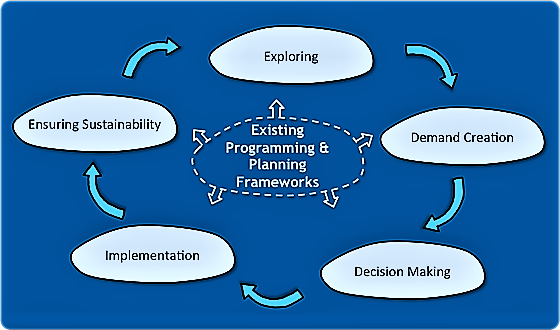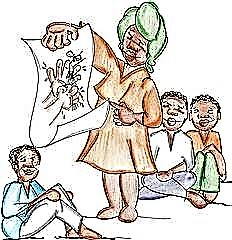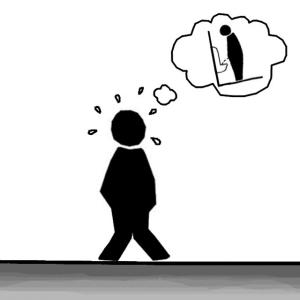Executive Summary
Various water and sanitation programmes have failed in the past because they were supply driven. It is of prime importance to understand that people will only apply those sustainable water and sanitation practices and technologies properly that they really want themselves (demand driven). Furthermore, communities will only accept solutions when they understand them and see their benefits. Demand for sustainable sanitation and water management systems is only created when end-users have motivation, opportunity and ability to invest in sanitation and water systems, which suits their needs and aspirations.
Introduction
Improving sanitation and water conditions of an area cannot be done only by implementing hardware such as constructing toilets or wastewater treatment plants. Many water and sanitation programmes have failed in the past because they were supply driven (organisations wanted something, not the people!). Even when there is impetus for sanitation and water improvement among the municipal authorities, the level of demand within the general population may be much lower. People will only use systems properly when they really want them themselves (demand driven). Furthermore, people will only accept solutions when they understand them and see their benefits.
Since sanitation and water management improvements require intervention at both household and community levels, raising the demand for such services from individuals is of paramount importance for the project’s success.
Demand for sanitation and water systems is only created when end-users have motivation, opportunity and ability to invest in a sanitation and water system which suits their needs and aspirations.
- Motivation: not by health messages but direct benefits; increased convenience, comfort, privacy, safety, avoidance of sexual harassment, prestige etc.
- Opportunity: access to good product, information, builders and materials, O&M services.
- Ability: resources needed to make use of opportunities, such as money, skill, transportation, control over decisions.
Demand creation is done after the exploring stage within a participatory planning when there is a lack of demand amongst the local people. Only if you have created demand for the sanitation and water system, you can move to the decision making step (see PPT).
Each of the participatory planning steps is supported by specific participatory planning tools.
Step 1: Identification of the Different Drivers at Different Levels of Society

Often, the hardware of supply-driven projects is poorly used and maintained and financially unsustainable, because the needs and desires of the local people were not considered sufficiently. In order to create demand for sustainable sanitation and water systems, it is necessary to identify what the community members actually desire, as well as to identify what aspects of sustainable sanitation and water management will be of most interest to them. When these drivers are identified, they will be used to convince the community to demand the adoption of sustainable sanitation and water systems.
An example: In a project in Mongolia, an NGO tried to make people interested in sanitation by telling them that this would improve their health. People were not very interested about this. Only when they learnt that the new toilets that were propagated were much more comfortable to use and – most importantly – did not smell bad, people got interested. The demand driver in this case is increased user comfort.
For the identification of these drivers, the planning team, together with the key stakeholders will have to organise consultations with selected members of the community in order to identify what they expect from the project. This consultation could be in the form of:
- Workshops: selected members of the community should be invited to workshops where they will be required to answer questions about what they want regarding sustainable sanitation and water systems (see e.g. focus groups).
- School essays: school children could be told to write short essays about what they and their parents could benefit from proper sanitation and water conditions as well as a clean environment (learn more about school campaigns).
- House-to-house visits: conducting visits to homes within the community could prove helpful as families could be asked about what they expect from sanitation and water systems.
- Community meetings: to discuss sanitation and water conditions , problems, solutions, etc.
- Other tools: in order to gain a better understanding of the existing sanitation and water condition in the area and its related problems, you can also use other exploring tools, such as problem tree analysis, transect walk, focus groups and description of settlement conditions, etc. Get an overview about exploring here.
Step 2: Awareness Raising Campaigns Targeting Stakeholders
By applying awareness raising (see PPT) tools you can support developing drivers for sustainable sanitation and water management within a community. Awareness raising tools aim on the one hand at making people aware of a certain problem or issue (or solution!), and at the other hand, it aims at integrating different stakeholders in improving water management and sanitation. Awareness raising, e.g. with different media campaigns, also helps to reach those stakeholders that are often forgotten (see e.g. radio campaigns, videos, posters and flyers, or internet and email).
To raise awareness for sustainable sanitation and water system it is important to promote its visibility and credibility of the organisation within a community or society. It is also of prime importance to inform and educate people in order to “elevate their level of knowledge” about the different options regarding sanitation and water. The intention is to influence their attitudes, behaviours and beliefs towards the achievement of sustainable sanitation and water solutions in their community. The ultimate goal of a sanitation and water awareness raising programme is to achieve such a degree of understanding and motivation that the members of the community can participate in the decision making process at a more informed level and that they participate in the realisation of the decisions taken.
Effective awareness raising will employ a variety of different communication approaches, techniques and tools to ensure that the central message is received and understood by a heterogeneous audience. Awareness raising demand time and financing and therefore require adequate support in planning, promoting and performing these activities. Such support will include fund raising, monitoring and networking. Once the support has been acquired, an effort should be made to promote the sustainable sanitation and water approach to all stakeholders.
Step 3: Identification of the Existing Components of the Supply Chain

Stimulating and supporting the demand for sustainable sanitation and water systems will put a high pressure on the supply side of hardware components, such as toilets, water pipes, wastewater plants, as well as qualified server providers. Thus, there is a need to organise a suitable supply chain, identifying companies and suppliers that could meet the demand. Local authorities, NGOs or CBOs working in the field should be capable of providing information about who offers the needed services, materials and equipment. It is of course also necessary to be in contact with the suppliers, otherwise any promotional effort will be useless.
Particularly for community-managed projects, i.e. where the members of the community will implement solutions themselves, it might be necessary to conduct training activities, e.g. in construction, but also in hygiene behaviour or maintenance. Furthermore, training workshops for micro enterprise formation could be offered in order to ensure that the demand for operation and maintenance, logistics for reuse, large scale construction of units, etc. will be covered (see also planning a training).
When Should Demand Be Created?
Depending on the type of project, demand creation takes place at different stages: If we are talking about a project that targets hygiene behaviour change, it is important to start to create demand right from the very beginning (see e.g. community let total sanitation (CLTS) and child hygiene and sanitation training (CHAST). Yet, if the project also contains technical importance, the appliances that are targeted must of course be available – e.g. if you promote composting toilets, the material needed to construct those, as well as the areas and projects where compost can be reused must be ready before you start raising demand – otherwise people will be turned down and their interest in the project will vanish.
Get an overview awareness raising tools for demand creation (see PPT) within SSWM.
Demand creation is an essential step within the participatory planning of sustainable sanitation and water management and is conducted after the exploring stage where you analyse the existing situation. Improving sanitation and water conditions of an area cannot be done only by implementing hardware such as constructing toilets or wastewater treatment plants. Many water and sanitation programmes have failed in the past because they were supply driven. Since sanitation and water improvements require intervention at both household and community levels, raising the demand for such services from individuals is of paramount importance for the project’s success.
NETSSAF Participatory Planning-Approach
This is the actual tutorial of the participative planning approach developed by NETSSAF, containing all the steps, sub-steps and case studies. It is freely available on the internet in French and English.
NETSSAF (2008): NETSSAF Participatory Planning-Approach. A tutorial for sustainable sanitation planning. Network for the Development of Sustainable Approaches for Large Scale Implementation of Sanitation in Africa (NETSSAF). [Accessed: 29.03.2010] PDFSanitation Marketing Dashboard
Consultant-led sanitation marketing surveys typically take months to produce a thick report with largely impractical recommendations. The IRC International Water and Sanitation is developing a field tool that delivers, within just one week, a one-page overview matching sanitation supply and demand. The tool, a sanitation marketing dashboard, was tested in two unions covered by the BRAC WASH II programme in Bangladesh.
BAETINGS, E. (n.y): Sanitation Marketing Dashboard. The Hague: IRC International Water and Sanitation Centre URL [Accessed: 02.10.2018]Handbook on Community Led Total Sanitation
This handbook about the CLTS approach contains a comprehensive description about how the approach was developed, came to live, and how this software can be implemented in one’s own community.
KAR, K. CHAMBERS, R. (2008): Handbook on Community Led Total Sanitation. UK: Plan International UK URL [Accessed: 17.04.2012]NETSSAF Participatory Planning-Approach
This is the actual tutorial of the participative planning approach developed by NETSSAF, containing all the steps, sub-steps and case studies. It is freely available on the internet in French and English.
NETSSAF (2008): NETSSAF Participatory Planning-Approach. A tutorial for sustainable sanitation planning. Network for the Development of Sustainable Approaches for Large Scale Implementation of Sanitation in Africa (NETSSAF). [Accessed: 29.03.2010] PDFHygiene and Sanitation Software. An Overview of Approaches
In sanitation and hygiene programme and service delivery, several methods are used to engage target groups in development programmes to enable behavioural change and/or create a demand for services. These methods or approaches are generally referred to as ‘software’, to distinguish them from the provision of ‚hardware‘. This publication takes an in-depth look at the various hygiene and sanitation software approaches that have been deployed over the last 40 years in all types of settings – urban, informal-urban and rural, and aims to address such issues as what a particular approach is designed to achieve, what it actually comprises, when and where it should be used, how it should be implemented and how much it costs, etc.
PEAL, A. EVANS, B. VAN DER WOORDEN, C. (2010): Hygiene and Sanitation Software. An Overview of Approaches. Geneva: Water Supply & Sanitation Collaborative Council (WSSCC) URL [Accessed: 16.06.2019]What Does It Take to Scale Up Rural Sanitation?
This working paper addresses lessons and best practices that were identified by the Water and Sanitation Program (WSP) to generate demand and supply for sanitation on the local and household level as well as strengthening governments in order to scale up sanitation projects.
PEREZ, E. CARDOSI, J. COOMBES, Y. DEVINE, J. GROSSMAN, A. KULLMANN, C. KUMAR, C.A. MUKHERJEE, N. PRAKASH, M. ROBIARTO, A. SETIWAN, D. SINGH, U. WARTONO, D. WSP (2012): What Does It Take to Scale Up Rural Sanitation?. (= Scaling Up Rural Sanitation ). Water and Sanitation Program (WSP)Analyser la demande des usagers
Dans toute démarche d’amélioration des services d’eau et d’assainissement, la demande est un enjeu primordial qui doit nécessairement être analysé et compris par les décideurs, planificateurs et concepteurs. Conçu pour optimiser l’allocation des ressources financières et favoriser l’équité entre usagers face des services publics de l’eau et de l’assainissement, ce guide fournit aux décideurs et acteurs de développement les clés de compréhension et les outils d’intervention pour mener à bien des analyses de la demande, à la fois rigoureuses et pragmatiques.
ROGER, G. (2010): Analyser la demande des usagers. (= Six Methodological Guides for a Water and Sanitation Services' Development Strategy , 3 ). Cotonou and Paris: Partenariat pour le Développement Municipal (PDM) and Programme Solidarité Eau (pS-Eau) URL [Accessed: 19.10.2011]Language: French
Community-Led Total Sanitation in Rural Areas. An Approach that Works
This document describes how the CLTS approach came to live, how it was further developed and how the application of this approach was dispread all over the world.
WSP (2007): Community-Led Total Sanitation in Rural Areas. An Approach that Works. Washington DC: Water and Sanitation Program URL [Accessed: 18.06.2019]Dealing with land tenure and tenancy challenges in water and sanitation services delivery
Providing water and sanitation services to the urban poor often takes place in contexts with complex formal and informal land ownership arrangements. How can these challenges be overcome? Drawing on WSUP’s experience in the African Cities for the Future (ACF) programme, this Topic Brief gives an overview of this area, and discusses possible solutions. The Topic Brief also offers practical guidance for programme managers.
WSUP (2013): Dealing with land tenure and tenancy challenges in water and sanitation services delivery . London: Water & Sanitation for the Urban Poor (WSUP) URL [Accessed: 24.06.2019]Hygiene Promotion
The benefits of hygiene promotion are generally not prioritised and the costs of hygiene promotion are poorly understood and therefore not adequately budgeted into programming. In this study WASHCost examined hygiene promotion and associated costs in Ghana, Mozambique, and Burkina Faso, looking at interventions that targeted latrine use and faecal containment, hand washing with soap, and the protection of drinking water.
IRC (2013): Hygiene Promotion. How Effective Is It? How Much Does It Cost? . (= WASHCost Infosheet , 5 ). The Hague: International Water and Sanitation Center (IRC) URL [Accessed: 24.06.2019]Full-Chain Sanitation Services That Last
This paper sets out a framework for the delivery of non-sewered sanitation services that last, are accessible to all and are at scale. The framework is based on IRC International Water and Sanitation’s (IRC) experience and lessons learnt from its engagement in non-sewered sanitation service at scale.
VERHAGEN, J. CARRASCO, M. (2013): Full-Chain Sanitation Services That Last. Non-Sewered Sanitation Services. The Hague: International Water and Sanitation Center (IRC) URL [Accessed: 03.06.2019]Sanitation Marketing
This paper deals with the methodology to create demand for sanitation by applying a social marketing approach. A project implemented by EcoSan Club in Northern Uganda serves as illustration.
LECHNER, M. (2013): Sanitation Marketing. Social Marketing – a Tool for Sanitation Behaviour Change?. In: Sustainable Sanitation Practice: Volume 16 , 21-23. URL [Accessed: 05.09.2013]Show Diarrhoea the Red Card
This paper introduces WASH United and its learning and behaviour change theory to create awareness and behaviour change for increasing the relevance of sanitation and hygiene practices. It describes how WASH United is using games and sport at the Great WASH Yatra in India and via WASH in Schools as well as the impact of these programmes.
JURGA, I. (2013): Show Diarrhoea the Red Card. WASH United: Using Fun, Games and Sport to Create Awareness and Behaviour Change. In: Sustainable Sanitation Practice: Volume 16 , 24-29. URL [Accessed: 05.09.2013]What Does It Take to Scale Up Rural Sanitation? Online Learning Course
This self-paced online course has been designed in partnership with the Water and Sanitation Program (WSP) of the World Bank to address important global challenges facing the water and sanitation sector. It is divided in 3 sections addressing respectively 1) examining fundamental aspects of sanitation provision, 2) examines the core theory of change for sustainable programmes and 3) enabling environment. Excluding associated reading, each section takes about one hour to complete.
WEDC (2013): What Does It Take to Scale Up Rural Sanitation? Online Learning Course. Loughborough: Water, Engingeering and Development Centre (WEDC) URL [Accessed: 09.04.2013]Training in Community-Led Total Behavior Change in Hygiene and Sanitation: The Amhara Experience in Line with the Health Extension Program
This manual provides a comprehensive training to build capacity of health extension workers (HEWs) and development agents to support total behavior change in hygiene and sanitation. Complete with exercises, facilitators notes, and tools.
WSP ; USAID-HIP (2009): Training in Community-Led Total Behavior Change in Hygiene and Sanitation: The Amhara Experience in Line with the Health Extension Program. Facilitators Guide. Bahir Dar, Ethiopia: Amhara National Regional State Health Bureau, World Bank Water and Sanitation Programme (WSP), USAID Hygiene Improvement Project (USAID-HIP) URL [Accessed: 24.06.2019]10 Keys for Local and National Action
Ten key points that are prerequisite for successful municipal wastewater management. They cover policy issues, management approaches, technology selection and financing mechanisms.
UNEP ; WHO ; UN-HABITAT ; WSSCC (2003): 10 Keys for Local and National Action . The Hague: United Nations Environment Programme Global Programme of Action (UNEP/GPA), Coordination Office URL [Accessed: 30.06.2019]IRC Sanitation reference package
IRC Sanitation Pack, SanPack for short, contains an overview of available methods, techniques and tools in a low-cost, non-sewered sanitation service model, including tools for demand creation. It is a reference guide containing links to relevant documents explaining the different stages in the sanitation cycle.

